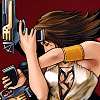There is still time to register for Writing Inclusive Games: Creating RPGs Sans Fail.
Tempest and I have a great syllabus planned! If you’re interested in working on RPGs, here’s a few things I want to point out for your consideration:
- 1. I’ve worked as a developer, writer, editor, creative consultant, worldbuilding consultant, and in marketing for over ten years on dozens of games with multiple companies. My knowledge, combined with K. Tempest Bradford’s, is enough to fill a set of encyclopedias. Take advantage of this!
2. The hobby games industry doesn’t train writers. You have to go to the companies you want to work for and apply. Like any other industry, there’s cultural aspects and processes in place that already exist. If you’re new and representation is important to you, then you might feel intimidated. We’re here to help.
3. People who design/produce games for the first time often make the same mistakes. The same is true when addressing representation. Knowing is half the battle, especially in an industry where costs are concerned. If you want to make your own game, there are many, many pitfalls to avoid that will save you time and money in the long run. We can point those out.
4. The exercises are designed to be flexible. I’ll review them with a developer’s eye in a safe space. Some companies don’t have the time for hands on feedback with freelance writers or designers. This class offers you the chance to write and get invaluable comments, which will prepare you for future assignments or show you how to critique your own work.
5. The class also addresses troubleshooting and methods to handle difficult situations. Creating RPGs is a complicated process with a lot of moving parts, and there may be problems that arise from time to time. Thanks to our combined experiences, Tempest and I can give you tips to assuage your fears and help you be more confident going forward.
For all these reasons and more, that’s why there’s a financial component attached to the class and why we can’t offer this for free. Writing Inclusive Games: Creating RPGs Sans Fail isn’t just about representation, it will also include a lot of information about the creation and marketing of RPGs as well to help you achieve your goals, too. Why? My philosophy is that if you’re paying for my time, whether that’s a RPG, a book, or a class, I want to make sure it’ll be well worth the effort.


